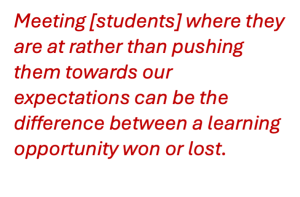I have zero talent in drawing or painting. My students giggle as I sketch something on the whiteboard, be it a cat, house, fork, whatever. I channel my creativity in other ways. In online classes, for example, I add artistic flourishes to my class presentations by using colourful and playful designs and animations. And since my students seem to like it, I thought, why not use more visual art to teach the course content?
Continue readingCategory Archives: Approaches
When the Moment Calls for Differentiated Instruction
We sometimes forget that learners are at different points along the learning continuum. Our students range from beginning to advanced, and all points in between. While we pitch our lessons to the middle, and expect our students to meet the objectives, the students at the lower end of the continuum tend to get left behind. Yet, these learners present us with the greatest opportunity for teaching and learning in the use of differentiated instruction.
Continue readingThe Magic of Inclusive Classrooms through Differentiated Instruction

Inclusive education means that all children have access to learning regardless of their social background, economic status, physical abilities or any trait which may potentially hinder them from their right to education. While this is a recent phenomenon influenced by Montessori methods and research on learner-centered classrooms, the shift actually has roots that go back hundreds of years to the one-room schoolhouse. It was formerly thought that all children learned in a similar way and at the same pace. It was only when achievement tests were introduced in 1912 that the disparity in the students’ grades became glaringly obvious. Continue reading
My shift to word chunks
Session after session, I integrate a “word of the day” into my lessons for students to add to their notebooks. I explain what the word means, provide examples of its use, and task them with using it that day. But I recently wondered whether it would be better to teach a “lexical chunk of the day” instead, as they tend to have a greater impact than isolated words. Also, students gravitate to these fixed expressions and are always asking what they mean. Indeed, well-known language educator Scott Thornbury supports this approach in Chunk-Spotting–A User’s Guide: “the possession of a memorized store of chunks allows more rapid processing, not only for production but also for reception. It’s quicker to process several words at a time rather than each word individually.”
Continue readingThe Triangle of Love for English: Nurturing Language Learning with Care and Passion
By: Margaret Holec
Language learning is a multifaceted journey that involves not only acquiring vocabulary and grammar rules but also fostering a deep connection with, and passion for, the language. In the realm of teaching English as a Second Language (ESL), educators often emphasize the importance of creating a supportive and engaging learning environment. One powerful concept that encapsulates this approach is the Triangle of Love for English.
The Triangle of Love for English represents three essential elements that contribute to effective language teaching and learning: the mind (intellectual aspect), the heart (emotional connection), and the mouth (language production). Let’s delve deeper into each element and explore how they work together to nurture language learning with care and passion.
Continue readingSharing Languages, Sharing Realities
As I scrambled to find an idea for today’s post, I mused about my classes over the last couple of weeks. Had any stood out in terms of student engagement? The answer hit me: our discussions on how language affects the way we see the world. Indeed, before we knew it, we had ventured into linguistic relativity, or the Sapir-Whorf hypothesis. These discussions sprang from our “Language and Culture” unit, specifically a TED Talk by Lindsay Morcom, Associate Professor and Canada Research Chair in Language Revitalization and Decolonizing Education at Queen’s University.
Continue readingIncorporating Listening Activities Into Literacy Classes

Literacy teachers emphasize reading and writing because those are the only two skills assessed at the literacy level. However, when does the attention given to those two skills become excessive? And, by devoting the bulk of class time to those two skills, do we do so at the expense of a holistic approach to teaching?
Continue readingMake Your Word-Processed Documents More Accessible
Most of us are aware of the importance of the issues around digital accessibility through our own disabilities and supporting our students in virtual and blended classrooms. Some organizations offer accessibility training for educators and learners. Due to accessibility legislation and policies, software vendors build accessibility features into their wares. This opportunity allows us to make our documents more accessible. This post suggests some features available in the Microsoft Word app that instructors may leverage to make their digital documents more accessible. Please be aware that this is not a comprehensive accessibility resource, but an introduction for interested educators. Continue reading
Smartphones can be a “Smart” Helper in the Classroom
At first glance, smartphones may seem like the ultimate language roadblock for ESL learners. The alluring prospect of effortlessly translating any text with a simple tap can lead to a habit of overreliance, hindering genuine language absorption. However, it’s not all doom and gloom. When approached with a strategic mindset, smartphones can indeed become “smart” tools in the ESL learning arsenal, especially for those who find themselves grappling with the complexities of English at a foundational level.
Continue readingTeaching To The Test

I had planned on giving one of my classes a task every Friday. What’s that saying? Ah, yes. Even the best laid plans. . . My plan was running like a well-oiled machine until the final week of classes before the Christmas break. I’d scheduled a writing task on December 15, and the class did it. That was not the problem. Time was. I didn’t have enough of it to cover all the material, and so I decided to teach to the test, or task, as it were.
Continue reading






